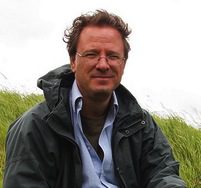
The Small Heart of Things is a calm book, told with patience, born from the idea that we need only to look around us to find the full wonder of the world. It’s an exploration of how a place becomes a home, and its essays cover—or uncover—the secret habitats of a variety of living things, from parakeets to beech trees to the people of neighboring lands. It’s a manual for how to tune in to an environment, and its range stretches from a single moth pinned in a collection case to the cosmic web of synchronicity that binds all human beings.
Fatigued by city life and in need of a change, Julian Hoffman and his wife leave London for the Prespa Lakes region in northern Greece, where the borders of that country come together with Albania and the former Yugoslav Republic of Macedonia. Hoffman is a bird enthusiast and studies the impact of wind farm technology on birds. They appear often in the book and are drawn simply and vividly, such as one species’ “black fretwork on its cinnamon back.” His observations about migration patterns and resettlement lead to larger lessons about adaptability. Goldfinches are just as comfortable in the mountain winter of Greece as they are in the parks in London, and this gives good instruction to a newly-relocated Hoffman: “Moving between disparate habitats with a grace that is both enviable and instructive, they are ultimately at home in the world.”
And being at home is at the heart of this book. Places are shadows, Hoffman notes, looming or shy or, in that perfect union of person and place, not visible at all. The moors of Hoffman’s youth in northern England, though only briefly part of his life, haunt and draw him, “sealed like a secret in an undisclosed part of me.” His travels to Istanbul connect him to a family that has journeyed from Afghanistan to Pakistan to Turkey, and Hoffman traces their path backward from a spice box, a souvenir, that he buys from the family’s son at a bazaar shop. A bed of reeds invites exploration into a hidden ecosystem, and a forest of beech trees becomes a contemplation of silence and space.
Hoffman’s musings, when he pulls away from the specifics into the abstract ideas and lessons he draws from them, are insightful and resonant, but he doesn’t dwell long there. Information about his motivations, challenges, and decisions—especially about making the move to rural Greece—are largely absent. And so readers may want more insight into his inner workings, to unpack his thoughts. The world is given so much careful attention, but our curiosity comes back to the teller.

But the absence of Hoffman in this way makes perfect sense. The book’s gift is its ability to capture a moment, to let the particulars contain the whole. If being present is the ultimate end, then it’s appropriate to stay lost in the forest. The focus of each essay is on the observed, not the observer. This isn’t a re-telling but a telling. And that’s Hoffman’s knack. He’s able to create a moment that feels like one. The markings on a bird, the food on a plate, a heron in battle with a snake.
The most compelling chapter concerns the disappearance of a man in a black suit whom Hoffman sees while hiking the English moors. When Hoffman crests a hill that the man has just walked over, there is no one on the path ahead or to the sides. He connects the incident to Nabokov, W.G. Sebald, and a chance encounter with a long-lost friend on a train—all of these lines underlining the power and awe of chance. Rather than spinning off into a more brainy discussion, Hoffman—wisely, expertly—lets the experience speak.
The book isn’t a travelogue about charming life in northern Greek villages, populated with eccentric characters and the freshest food that common readers will never eat. And it isn’t a guide to enlightenment by someone who’s enlightened, making readers feel acutely in the dark. Hoffman is sincere, earnest. These meditations are meditations—he’s thought about them, sat with them and put words carefully around them. Each chapter has the feel that Hoffman is learning and discovering at the same moment as the reader. Let’s wander, he says, as though it’s the first parting of the reeds.
Hoffman’s travels aren’t idyllic or sanitized, either. The very real and bloody history of the Prespa Lakes region intrudes on the present. A paragraph that begins with Coastal Clean-Up Day along the lakes, and its promise of doing good for the environment, runs into this sentence: “When the bomb detonated along the shore, we all lapsed into silence.” Old ordnance from Greece’s civil war hides in the land. Hoffman recounts, too, Albania and its decades-long enforced isolation, its hundreds of thousands of concrete bunkers built because of a ruler’s paranoia. Scars and artillery are just as much a part of life as the birds and mountains.
The message of finding wonder in our surroundings, as familiar as it may seem, is fresh here. The prose soothes. The pages absorb you. Hoffman’s world is endlessly instructive and inclusive. It’s our world, too, if we wish to see it that way. An environment on its own is uninflected, but it becomes a home when we attach experience to it. Any place—and every place—can be a home. The Small Heart of Things is a celebration of spaces and the hidden, miraculous lives within them, but it’s a quiet celebration, the pause after you open a gift, truly surprised, and inhabit a speechless moment.




